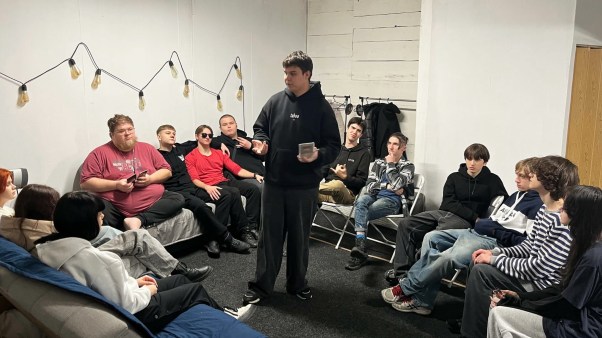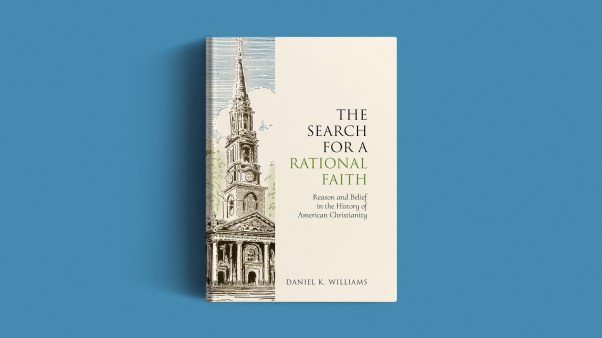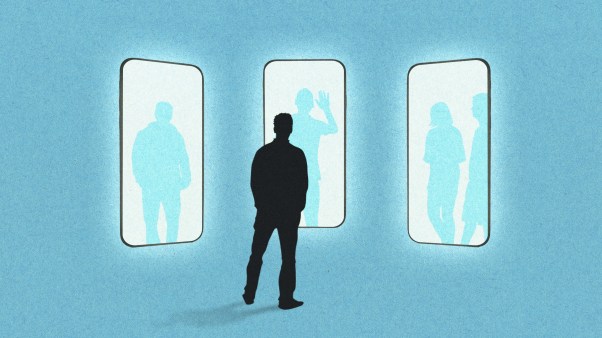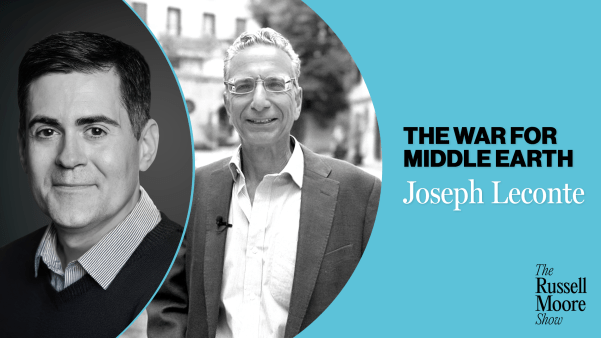At a 2016 rally in South Carolina, future president Donald Trump ended his stump speech with an unusual appeal: “It’s all morphed into one big beautiful package. And the package is called you, but maybe it’s in the form of me. The beautiful package that we’re going to do. And you’re going to be so proud. And you’re going to be so happy. And you’re going to win again.”
Trump’s strange crescendo supplies one of the closing anecdotes in historian Molly Worthen’s absorbing new book, Spellbound: How Charisma Shaped American History from the Puritans to Donald Trump. This could appear odd at first glance given that Trump, despite abounding with charisma, might not seem like an obvious example of Worthen’s core subject, charisma’s spiritual power. But Trump and his adherents illustrate something essential about her definition of charisma as something fundamentally relational.
A charismatic leader offers followers an opportunity to feel connected to a grander narrative, which imparts a sense of greater importance to their lives. As Worthen observes, they believe they have surrendered to something larger than themselves, gaining entry into “an alternative world in which followers find that they have secret knowledge, supernatural promise, and special status as heroes.” While this relationship grants the charismatic leader great power or prestige, it remains fundamentally an exchange, “a liturgical act” in which the two parties “consecrate a new reality.”
Yet this charismatic relationship is simultaneously powerful and brittle. Drawing on the thought of sociologist Max Weber, who analyzed the relationship between charisma and authority, Worthen notes that charismatic leaders must ultimately prove the authenticity of their divine mission through the flourishing of their followers. “If they do not fare well,” she writes, then the leader “is obviously not the master sent by the gods.” Thus, charisma is “an alloy of authoritarian and democratic impulses, strong enough to overturn social orders, yet somehow so weak that it melts away if followers cease to honor it.”
To return to the charisma of Donald Trump, his personal story often follows this kind of framing. His gilded wealth and political success supposedly confirm that he lives a #blessed life, from his victories over bankruptcy to what he said was the divine redirection of an assassin’s bullet in Butler, Pennsylvania. He then invites his followers to participate in his blessing, joining his grand struggle to make America great again while pouring out his anointing on their own finances, communities, and aspirations.
Yet the spell can break if the promise goes unfulfilled. If, say, Trump’s tariff and immigration policies were to hamper American prosperity or tear apart families and communities, followers might come to reject him as a false prophet.
Charisma, then, depends on a leader’s ability to craft a message in tune with the anxieties and insecurities of a particular place and time. In the case of America over the last half century, many of those core anxieties have arisen in response to secularization, which Worthen defines as the process by which traditional institutions—in both religion and politics—lose influence over our lives.
We see these patterns in declining rates of church attendance, waning trust in political parties, and networks of civic and communal participation giving way to habits of “bowling alone” (to use Robert Putnam’s memorable phrase). But none of this saps people of their fundamental need for spiritual succor. Secularization merely opens a void for charismatic entrepreneurs, who offer to fill it with a force of personality and a grand narrative.
This is hardly new. For example, in the 1830s, the “burned-over district” of Western New York witnessed waves of religious revivalism, democratic revolution, and economic transformation. With established authorities and institutions swept aside, a range of treasure –hunters, millenarian prophets, and metaphysical entrepreneurs rushed in to take their place.
The resulting upheaval birthed groups as diverse as Joseph Smith’s Mormons, the Millerites (named after lay Baptist preacher William Miller, who predicted that Jesus would return to earth around 1843), and the spiritualists poking at the veil between the living and the dead. Despite substantial differences in theology and practice, these groups united around their rejection of Puritan theological conventions and their embrace of common-sense realism—a belief, in Worthen’s words, that “humans perceive the world directly and reliably with their senses.”
This kind of confidence naturally fuels a measure of skepticism toward the claims of expertise and the weight of educational credentials. As David Reese, a New York City medical doctor in the 1830s, put it, charlatans
have only to decry all existing systems, denounce all the learning of the schools, condemn and revile all prevalent opinions on any and every subject, and they will find here a great multitude of disciples, who will eagerly listen to their oracular teachings, and drink in wisdom and knowledge with the most marvelous credulity.
This sensibility should not strike modern readers as particularly alien. One might as well be discussing contemporary suspicions of university-produced expertise or calls to “Make America Healthy Again” fueled by widespread distrust of the medical establishment.
The similarity between anti-elite sentiments in the 1830s and the 2020s illustrates another of Worthen’s core contentions:, that charisma is cyclical. Charismatics see–saw from generation to generation between those inclined to tear down existing social institutions and those seeking “metaphysical conquest” or mastery over social anxiety through a kind of spiritual scientism. While tracing this crooked path, Worthen constructs a taxonomy (at times overly rigid) of the five types of charismatic leaders: prophets, conquerors, agitators, experts, and gurus. Each type may respond differently to the challenges of a particular era, but they do so in ways that echo across the generations.
Consider for instance, what fundamentally unites the 19th-century occultist “investigator” who explored the afterlife at a seance and the 21st-century podcast host who proclaims the liberating power of “do[ing] your own research.” Both figures embody a rejection of expertise, differing only in the specific authorities they spurn, whether Puritan divines or pointy-headed academics with worthless pieces of paper on their walls.
Worthen makes these kinds of surprising connections throughout the book. She does not draw neat lines between sacred and secular modes of charisma. After all, they flow from similar ideas or impulses.
For instance, Worthen observes common tendencies within the various countercultural movements of the 1960s–1970s, lumping together charismatics as ostensibly dissimilar as left-wing activist Angela Davis, end-times writer Hal Lindsey, Marxist theorist Herbert Marcuse, and faith-healing preacher Kathryn Kuhlman. Each movement, Worthen writes, “acted upon a deeper … emotional substrate” rooted in disenchantment with established authority and a desire for “personal experiences that felt real and important when so much around them seemed phony and pointless.” Worthen, in other words, invites readers to consider the fundamental spirit of a given age, not merely how it manifests in particular figures or movements.
Along the way, she conveys both the breadth and the depth of the American religious tradition, from Shakers and spiritualists to Mormons and mesmerists. Familiar figures like Puritan dissenter Anne Hutchinson appear alongside more unfamiliar names, like Dona Beatriz Kimpa Vita, whom Worthen calls the “Kongolese Joan of Arc.” Or Benjamin Lay, the abolitionist Quaker radical and “holy fool” who shocked his Philadelphia congregation by plunging a sword into a Bible filled with fake blood to dramatize God’s judgment against slaveholders. At times, readers might lose Worthen’s through line amid a welter of anecdotes, but her vignettes are vividly told.
Worthen takes the figures often relegated to the periphery (if they are mentioned at all), like Lay and Kimpa Vita, and places them back in the main line of the American religious tradition. In this way, she avoids the survivorship bias that crops up in certain historical accounts that assume a movement’s numerical growth and chronological persistence are reliable measures of its significance.
If Worthen’s book contains one major omission, it pertains to the role of technology in cultivating and amplifying charisma. Spellbound includes ample references to charismatic use of mass media technology, especially radio, from the likes of Franklin Delano Roosevelt, Charles Coughlin, and Rush Limbaugh. Yet the book provides little substantive analysis of this phenomenon. For Worthen, “new media technology has always shaped the expression of American charisma, but it has never been the marrow.”
This may represent a needed corrective to ritual invocations of Marshall McLuhan, for whom “the medium is the message.” And yet it is not mere happenstance that many of the charismatic entrepreneurs Worthen so ably describes were also pioneers of new mass media, from Robert “Fighting Bob” Shuler and Aimee Semple McPherson in Roaring ’20s Los Angeles to televangelists like Pat Robertson and Jerry Falwell in 1980s Virginia.
New technologies and communications have allowed a dizzyingly diverse array of charismatic insurgents to leapfrog incumbent denominations and stale institutions. Whether it is tales of fortune-finding magical seer stones, the social media lamentations of Donald Trump, or visions of the imminent return of Christ, all stories—even the prophetic ones—rely on a means of distribution to break through the noise.
This does not diminish Worthen’s accomplishment with this book. She offers a compelling corrective to the blander species of religious history produced for a churchly audience, which has a habit of sanitizing the past, stripping it down to a dutiful trudge from forefather through forefather that eventually arrives at the front steps of the First Baptist (or Methodist or Presbyterian) Church down the street. Worthen restores a sense of wildness to the history of Christianity in America, inviting the reader to glimpse the charismatic bonds that entice and enchant us all.
Paul Matzko is a historian specializing in the intersection of politics, religion, and technology in modern America. He is the author of The Radio Right: How a Band of Broadcasters Took On the Federal Government and Built the Modern Conservative Movement.

















